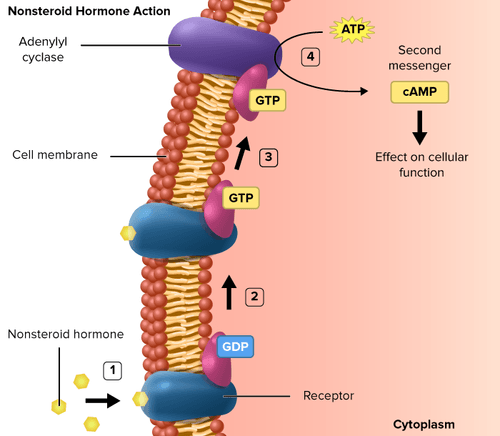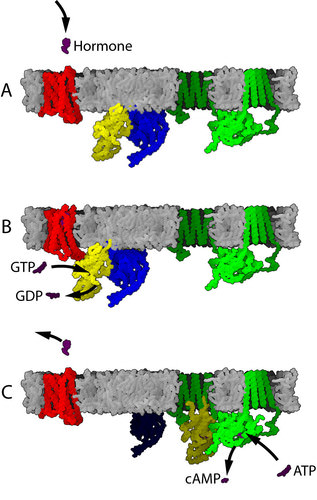4.35 信号转换 - 高级
章节大纲
-
How is information transduced from the outside of the cell?
::如何从细胞外部传输信息?It starts with the ligand binding its receptor. Once the signal is internalized, the second messenger then begins a cascade of reactions that can greatly change the behavior of the .
::一旦信号内部化,第二个信使就会开始一系列反应, 从而大大改变其行为。Signal Transduction
::信号转换A signal- transduction pathway is the signaling mechanism by which a cell changes a signal on its surface into a specific response inside the cell. This process begins when a ligand binds to its receptor. The receptor may either be a cell-surface receptor in the or a nuclear receptor in the cytoplasm of the cell.
::信号传输路径是信号机制,通过这一机制,细胞可以将表面的信号转换成细胞内部的特定反应。这一过程始于离子与受体捆绑时。受体可以是细胞表面的细胞受体,也可以是细胞细胞顶模中的核受体。Signal transduction most often involves an ordered sequence of chemical reactions inside the cell which is carried out by and other molecules. In many signal transduction processes, the number of and other molecules participating in these events increases as the process progresses from the binding of the signal. A "signal cascade" begins. Think of a signal cascade as a chemical domino-effect inside the cell, in which one domino knocks over two dominoes, which in turn knock over four dominoes, and so on. The advantage of this type of signaling to the cell is that the message from one little signal molecule can be greatly amplified and have a dramatic effect.
::信号转换最经常涉及细胞内部化学反应的有序序列,由分子和其他分子进行。在许多信号转换过程中,参与这些事件的分子数量和其他分子数量随着信号捆绑过程的进展而增加。一个“信号级联”开始。将信号级联想象成细胞内部的化学多米诺效应,其中一位多米诺人击倒两个多米诺人,然后击倒四个多米诺人,等等。这种向细胞发出信号的优势是,一个小信号分子发出的信息可以大大放大,并具有戏剧性效果。How a G-protein linked receptor works with the help of a G-protein.
::G-蛋白质连接受体如何在G-蛋白质的帮助下工作。G Proteins
::G蛋白质G proteins (guanine nucleotide-binding proteins) are a family of GTPases involved in transmitting chemical signals outside the cell, and causing changes inside the cell. When a ligand binds to a G protein coupled receptor, an intracellular of the receptor activates a G protein. The G protein then activates additional intracellular pathways, resulting in an altered intracellular environment. G proteins function as molecular switches. When they bind guanosine triphosphate (GTP), they are 'on', and, when they bind guanosine diphosphate (GDP), they are 'off'.
::G蛋白质(guaine nucleotide- contactive 蛋白质)是一组GTPases,它们参与向细胞外传送化学信号,并在细胞内造成变化。当磁带与G蛋白结合受体结合时,受体内部细胞会激活G蛋白质。G蛋白随后会激活更多的细胞内途径,导致细胞内环境发生变化。G蛋白质作为分子开关发挥作用。当它们结合瓜诺辛三磷酸(GTP)时,它们是“on ” , 当它们结合guanosine di 磷酸酯(GDP)时,它们是“关闭 ” 。G Protein Coupled Receptors and Cyclic AMP
::G 蛋白因混合受体和cyclic AMPG protein linked receptors are only found in higher eukaryotes , including yeast, plants, and . Your of sight and smell are dependent on G-protein linked receptors. The ligands that bind to these receptors include light-sensitive compounds, odors, , and neurotransmitters . The ligands for G-protein linked receptors come in different sizes, from small molecules to large proteins. When a ligand binds to the receptor, it causes a conformational change in the receptor, which allows it to act as a guanine nucleotide exchange factor. The receptor can then activate an associated G-protein by exchanging its bound GDP for a GTP. The G-protein's α subunit, together with the bound GTP, can then dissociate from the β and γ subunits to further affect intracellular signaling proteins.
::G-蛋白连接受体的离子体大小不一,从小分子到大蛋白。当离子和与受体结合时,会使受体发生相近的变化,使受体能够作为抗体核核素交换因子发挥作用。受体随后可以通过交换受体的受体的受体约束GDP来激活相关的G-蛋白质。G-蛋白连接受体的离子体与受体的受体有不同大小,从小分子到大蛋白。当离子和受体结合时,它会引发受体的相近变化,使受体能够作为抗生素核素交换因子。然后受体可以通过为GTP交换其约束GDP来激活相关的G-蛋白质。G-protein的α子单元与受体的受体GTP,可以与受约束的受体分单元分开,从而进一步影响细胞内信号蛋白质。Many times the activated G-protein-linked receptor will then activate cyclic AMP (cAMP) , which acts as the second messenger in initiating a cascade of reactions.
::激活的G-蛋白质相关受体将多次激活循环AMP(cAMP),该AMP是引发一系列反应的第二使者。The process of how a G-protein linked receptor works is outlined in Figure .
::图3概述了G-蛋白质连接受体工程的过程。How a G-protein linked receptor works with the help of a G-protein. In panel C, the second messenger cAMP can be seen moving away from the enzyme.
::G-蛋白质链接受体如何在G-蛋白质的帮助下工作。 在C小组中,第二位信使CAMP(CAMP)从酶中消失了。G-Protein Linked Receptors
::G-Protein 连接受体-
A ligand such as a hormone (small, purple molecule) binds to the G protein-linked receptor (red molecule). Before ligand binding, the inactive G-protein (yellow molecule) has GDP bound to it.
::诸如荷尔蒙(小紫分子)等离子体与G蛋白相关受体(红分子)相连。 在离子结合之前,非活性G-蛋白(黄分子)具有GDP约束。 -
The receptor changes shape and activates the G-protein and a molecule of GTP replaces the GDP.
::受体改变形状,激活G蛋白质,GTP的一个分子取代GDP。 -
The G-protein moves across the membrane then binds to and activates the enzyme (green molecule). This then triggers the next step in the pathway to the cell's response. After activating the enzyme, the G-protein returns to its original position. The second messenger of this signal transduction is cAMP, as shown in C.
::G-蛋白因穿过膜移动,然后与酶(绿色分子)捆绑并激活。 这会触发细胞反应路径的下一步。 在激活酶后, G- 蛋白因返回原位置。 信号传输的第二个发送者是 CAMP, 如 C 所示 。
The sensing of the external and internal environments at the cellular level relies on signal transduction. Defects in signal transduction pathways can contribute or lead to many diseases, including and heart disease. This highlights the importance of signal transductions to biology and medicine.
::在细胞层面对外部和内部环境的感知依赖于信号转换,信号转换途径的缺陷可能或导致许多疾病,包括心脏病,这凸显了信号转换对生物学和医学的重要性。G-protein linked receptors are also involved in the phosphatidylinositol (PI) signal pathway. In this pathway, PI can be phosphorylated to form phosphatidylinositol phosphate (PIP), phosphatidylinositol bisphosphate (PIP 2 ) and phosphatidylinositol trisphosphate (PIP 3 ), which are collectively called phosphoinositides. These molecules play important roles in signaling, cell signaling and membrane trafficking.
::G-蛋白质相关受体也参与磷酸丁酯(PI)信号路径,在这一路径中,PI可被磷酸化成磷酸丁酯磷酸酯(PIP)、磷酸丁酯乙基磷酸酯(PIP2)和磷酸丁酯三磷酸酯(PIP3),这些共称为磷酸酯,这些分子在信号、细胞信号和膜贩运方面发挥着重要作用。Signal Response
::信号反应In response to a signal, a cell may change activities in the cytoplasm or in the that include the switching on or off of genes . Changes in metabolism , continued growth, movement , or death are some of the cellular responses to signals that require signal transduction.
::在响应信号时,细胞可能会改变细胞板的活动或包括基因开关或关闭的活动。 新陈代谢、持续增长、移动或死亡的变化是细胞对需要信号转换的信号的一些反应。Gene activation leads to other effects, since the protein products of many of the responding genes include enzymes and factors that increase . Gene expression factors produced as a result of a cascade can turn on even more genes. Therefore one stimulus can trigger the expression of many genes, and this in turn can lead to the activation of many complex events. In a these events include the increased uptake of glucose from the stream (stimulated by insulin), and the movement of neutrophils to sites of infection (stimulated by bacterial products). The set of genes and the order in which they are activated in response to stimuli are often called a genetic program.
::基因激活还会产生其他效果,因为许多反应基因的蛋白质产品包括酶和增加的因素。由级联产生的基因表达因素可以触发更多的基因。因此,一种刺激可以触发许多基因的表达,而这反过来又可能导致许多复杂事件的激活。 在这些事件中,包括增加从溪流中吸收葡萄糖(由胰岛素刺激),以及将中微营养素转移到感染地点(由细菌产品刺激)。基因组及其因刺激性而激活的顺序往往被称为基因方案。Signal transduction pathways. Ras (upper middle section) activates a number of pathways but an especially important one seems to be the mitogen-activated protein kinases (MAPK). MAPK transmit signals downstream to other protein kinases and gene regulatory proteins. Note that many of these pathways are initiated when a signal binds to its receptor outside the cell. Most pathways end with altered gene regulation and cell proliferation. The p53 tumor suppressor protein is shown at the lower section of the figure stimulating p21. The complexity of the pathways demonstrate the significant role these play in the cell.
::信号传输路径 。 Ras ( 上中段) 激活了许多路径, 但其中一种特别重要的路径似乎是 分子活性蛋白动脉( MAPK) 。 MAPK 将信号传送到下游其他蛋白异脉和基因调节蛋白质。 请注意, 许多这些路径都是当信号与细胞外的受体连接时启动的。 大多数路径都以改变基因调节和细胞扩散而结束。 p53 肿瘤抑制蛋白在图的下一节显示刺激的 p21 。 路径的复杂性显示了这些信号在细胞中的重要作用 。Summary
::摘要-
Signal transduction occurs when a ligand binds its receptor and alters intracellular conditions.
::当电线捆绑其受体并改变细胞内部条件时,即发生信号感应。 -
Often the signal is transducer from the outside of the cell to the inside.
::信号通常是从细胞外部到内部的传感器。 -
This process usually involves G-protein linked receptors and cyclic AMP.
::这一过程通常涉及G-蛋白质连接受体和循环AMP。
Review
::回顾-
Define G-protein.
::定义G蛋白质。 -
Describe the process of signal transduction, focusing on the roles of G-protein linked receptors and cyclic AMP.
::描述信号转换过程,侧重于G-蛋白联接受体和循环AMP的作用。
Explore More
::探索更多Use this resource to answer the questions that follow.
::使用此资源回答下面的问题 。-
Describe a general signal transduction pathway.
::描述一般信号传输路径。 -
What is meant by a phosphorylation cascade?
::磷酸化级联是什么意思? -
How is adenyl cyclase activated? What is the role of adenyl cyclase?
::代环苯是如何激活的?代环苯的作用是什么? -
Describe the role of cAMP.
::描述《保护海洋环境免受陆上活动污染公约》的作用。 -
How is protein kinase activated? What is the role of protein kinase?
::蛋白质动脉素是如何激活的?蛋白质动脉素的作用是什么?
-
A ligand such as a hormone (small, purple molecule) binds to the G protein-linked receptor (red molecule). Before ligand binding, the inactive G-protein (yellow molecule) has GDP bound to it.



